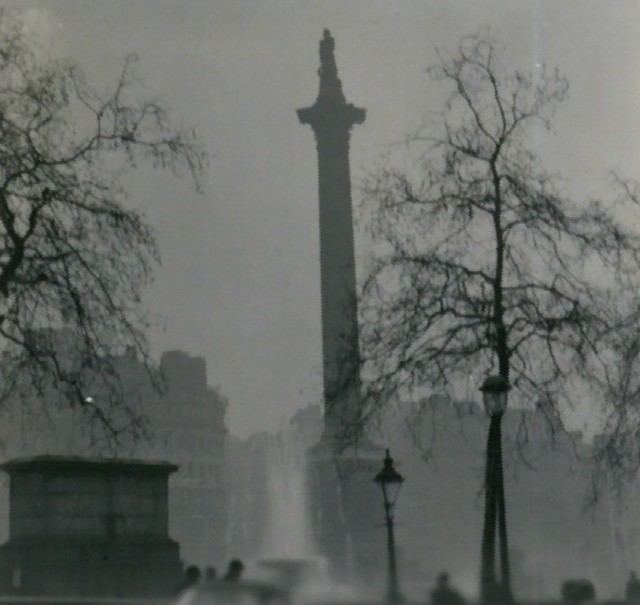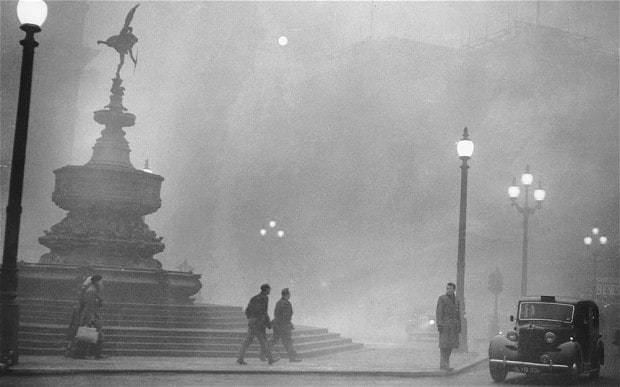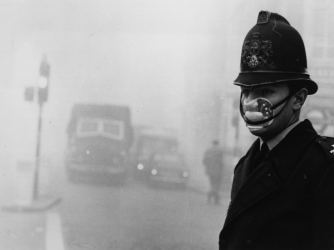Dates 5 Dec 1952 – 9 Dec 1952 | ||
 | ||
Similar 1948 Donora smog, Great Stink, Bhopal disaster, Great Plague of London, Great Fire of London | ||
Great smog of london documentary
The Great Smog of 1952, sometimes called The Big Smoke , was a severe air-pollution event that affected the British capital of London in December 1952. A period of cold weather, combined with an anticyclone and windless conditions, collected airborne pollutants – mostly arising from the use of coal – to form a thick layer of smog over the city. It lasted from Friday, 5 December to Tuesday, 9 December 1952 and then dispersed quickly when the weather changed.
Contents
- Great smog of london documentary
- Sources of pollution
- Weather
- Effect on London
- Health effects
- Environmental impact
- Cause
- In popular culture
- References

It caused major disruption by reducing visibility and even penetrating indoor areas, far more severe than previous smog events experienced in the past, called "pea-soupers". Government medical reports in the following weeks, however, estimated that up until 8 December, 4,000 people had died as a direct result of the smog and 100,000 more were made ill by the smog's effects on the human respiratory tract. More recent research suggests that the total number of fatalities was considerably greater, about 12,000.

London had suffered from poor air quality since the 1200s, which worsened in the 1600s, but the Great Smog is known to be the worst air-pollution event in the history of the United Kingdom, and the most significant in terms of its effect on environmental research, government regulation, and public awareness of the relationship between air quality and health. It led to several changes in practices and regulations, including the Clean Air Act 1956.

Sources of pollution

The cold weather preceding and during the Great Smog led Londoners to burn more coal than usual to keep warm. Post-war domestic coal tended to be of a relatively low-grade, sulphurous variety (economic necessity meant that better-quality "hard" coals tended to be exported), which increased the amount of sulphur dioxide in the smoke. There were also numerous coal-fired power stations in the Greater London area, including Fulham, Battersea, Bankside and Kingston upon Thames, all of which added to the pollution. According to the UK's Met Office, the following pollutants were emitted each day during the smoggy period: 1,000 tonnes of smoke particles, 140 tonnes of hydrochloric acid, 14 tonnes of fluorine compounds, and 370 tonnes of sulphur dioxide which may have been converted to 800 tonnes of sulphuric acid.
Research suggests that additional pollution-prevention systems fitted at Battersea may have worsened the air quality, reducing the output of soot at the cost of increased sulphur dioxide, though this is not certain. Additionally, there was pollution and smoke from vehicle exhaust – particularly from steam locomotives and diesel-fuelled buses, which had replaced the recently abandoned electric tram system – and from other industrial and commercial sources. Prevailing winds had also blown heavily polluted air across the English Channel from industrial areas of Continental Europe.
Weather
On 4 December 1952, an anticyclone settled over a windless London, causing a temperature inversion with cold, stagnant air trapped under a layer (or "lid") of warm air. The resultant fog, mixed with chimney smoke, particulates such as those from vehicle exhausts, and other pollutants such as sulphur dioxide, formed a persistent smog, which blanketed the capital the following day. The presence of tarry particles of soot gave the smog its yellow-black colour, hence the nickname "pea-souper". The absence of significant wind prevented its dispersal and allowed an unprecedented accumulation of pollutants.
Effect on London
Although London was accustomed to heavy fogs, this one was denser and longer-lasting than any previous fog. Visibility was reduced to a few metres ("It's like you were blind") making driving difficult or impossible.
Public transport ceased, apart from the London Underground; and the ambulance service stopped functioning, forcing users to transport themselves to hospital. The smog even seeped indoors, resulting in the cancellation or abandonment of concerts and film screenings as visibility decreased in large enclosed spaces, and stages and screens became harder to see from the seats. Outdoor sports events were also affected.
In the inner London suburbs and away from town centres there was no disturbance by moving traffic to thin out the dense fog in the back streets. The result was that visibility could be down to a metre or so in the daytime. Walking out of doors became a matter of shuffling one's feet to feel for potential obstacles such as road kerbs. This was made even worse at night since each back street lamp at the time was fitted with an incandescent light-bulb, which gave no penetrating light onto the pavement for pedestrians to see their feet, or even the lamp post. Fog-penetrating fluorescent lamps did not become widely available until later on in the 1950s. "Smog masks" were worn by those who were able to purchase them from chemists.
Near railway lines, on which "fog working" was implemented, loud explosions similar to the report of a shotgun were a common feature. The explosions were made by "detonators" – a form of large percussion cap placed on the track and activated by the wheels of trains. These devices were placed by certain signals to provide an audible warning to match the visual indication provided by the signal for the driver.
Health effects
There was no panic, as London was renowned for its fog. In the weeks that ensued, however, statistics compiled by medical services found that the fog had killed 4,000 people. Most of the victims were very young or elderly, or had pre-existing respiratory problems. In February 1953, Lieutenant-Colonel Lipton suggested in the House of Commons that the fog had caused 6,000 deaths and that 25,000 more people had claimed sickness benefits in London during that period.
Mortality remained elevated for months after the fog. A preliminary report, never finalised, blamed the ongoing deaths on an influenza epidemic. Emerging evidence revealed that only a fraction of the deaths could be from influenza. Most of the deaths were caused by respiratory tract infections, from hypoxia and as a result of mechanical obstruction of the air passages by pus arising from lung infections caused by the smog. The lung infections were mainly bronchopneumonia or acute purulent bronchitis superimposed upon chronic bronchitis.
More recent research suggests that the number of fatalities was considerably greater than contemporary estimates, at about 12,000.
Environmental impact
The death toll formed an important impetus to modern environmentalism, and it caused a rethinking of air pollution, as the smog had demonstrated its lethal potential. New regulations were implemented, restricting the use of dirty fuels in industry and banning black smoke.
Environmental legislation since 1952, such as the City of London (Various Powers) Act 1954 and the Clean Air Acts of 1956 and 1968, led to a reduction in air pollution. Financial incentives were offered to householders to replace open coal fires with alternatives (such as installing gas fires), or for those who preferred, to burn coke instead which produces minimal smoke. Central heating (using gas, electricity, oil or permitted solid fuel) was rare in most dwellings at that time, not finding favour until the late 1960s onwards. Despite improvements, insufficient progress had been made to prevent one further smog event approximately ten years later, in early December 1962.
Cause
Atmospheric scientists at Texas A&M University investigating the haze of polluted air in Beijing realized their research led to a possible cause for the London event in 1952. "By examining conditions in China and experimenting in a lab, the scientists suggest that a combination of weather patterns and chemistry could have caused London's fog to turn into a haze of concentrated sulfuric acid."
Even though research findings point in this direction, the two events are not identical. In China, the combination of nitrogen dioxide and sulfur dioxide, both produced by burning coal, with a humid atmosphere, created sulfates while building up acidic conditions that, left unchanged, would have stalled the reaction. However, ammonia from agricultural activity neutralized the acid allowing sulfate production to continue.
It is theorized that in 1952 in London, the nitrogen dioxide and sulfur dioxide combined with fog rather than humidity; larger droplets of water diluted the acid products, allowing more sulfate production as sulfuric acid. Sunrise burned off the fog, leaving concentrated acid droplets which killed citizens.
In popular culture
The Great Smog served as the basis of an episode titled "Forog" of The Goon Show (series 5, episode 13), which aired on 21 December 1954.
The Great Smog was a central plot line in season 1, episode 4 of the Netflix series The Crown (released in November 2016).
